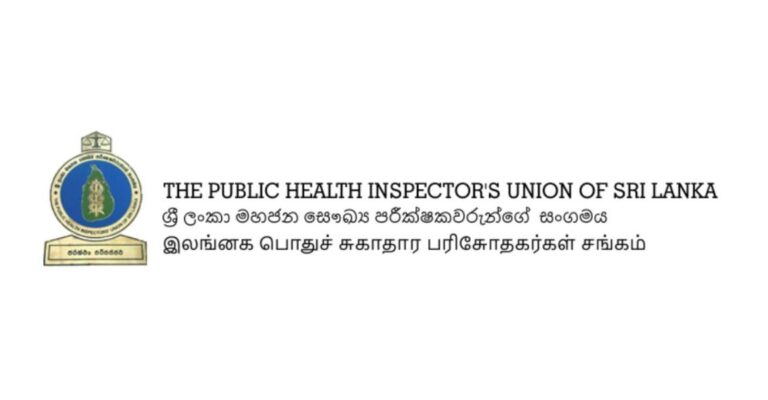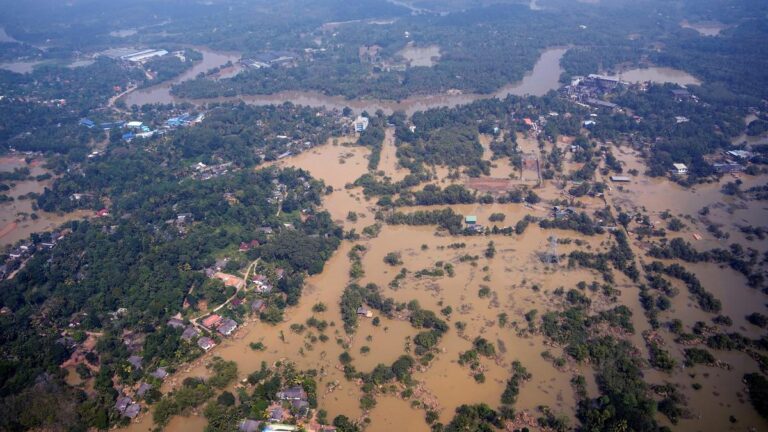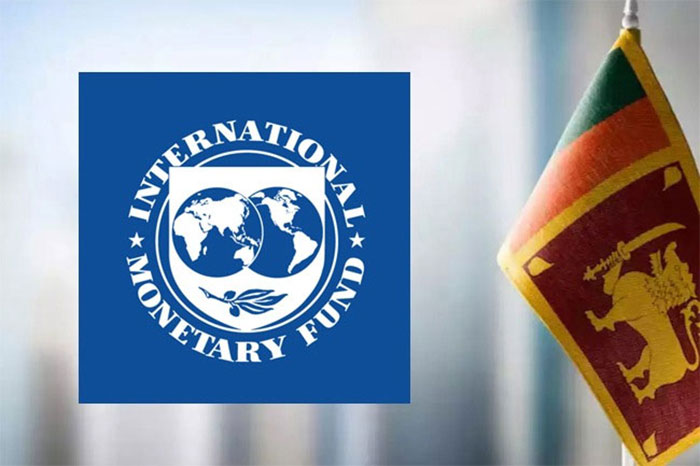December 08, Colombo (LNW): A substantial shipment of humanitarian aid from China, valued at approximately Rs. 400 million, reached Sri Lanka today to assist communities affected by recent natural disasters.
The cargo plane landed at Bandaranaike International Airport (BIA) in Katunayake this morning, having flown directly from Shanghai.
The Boeing 747 freighter, carrying over 84 tonnes of relief supplies, touched down at 10:47 a.m., according to local reporters. Among the donated items are inflatable life jackets, tents, blankets, and bed linens, intended to provide immediate relief to those displaced or severely impacted by the floods.
A high-level delegation was present to welcome the aid, including Minister of Ports and Civil Aviation Anura Karunathilaka, Deputy Minister of Defence Aruna Jayasekara, and Chinese Ambassador Qi Zhenhong.
Massive Aid Shipment from China Arrives to Support Flood-Hit Communities in Sri Lanka
DMC urges public not to venture into areas affected by flooding
December 08, Colombo (LNW): Pradeep Kodippili, head of the Disaster Management Centre (DMC), has cautioned the public against venturing into areas recently affected by severe flooding, describing the conditions as highly perilous.
He particularly warned against swimming or entering rivers and streams carrying swift currents.
Relief operations are actively underway to support communities impacted by the heavy rainfall. Residents are encouraged to report any urgent concerns or requests for assistance directly to the DMC via the hotline 117.
Kodippili also highlighted that the persistent rain has left the ground heavily saturated, increasing the risk of landslides and other hazards.
He stressed the importance of adhering to official warnings and evacuating immediately if a red alert is issued.
The DMC Director extended his gratitude to relief personnel from India and Pakistan, noting their significant contribution to ongoing humanitarian efforts.
Authorities Confiscate 12 Tonnes of Flood-Damaged Meat
December 08, Colombo (LNW): Public Health Inspectors in Anuradhapura have removed 12,000 kilogrammes of meat from circulation after it was found to be unfit for consumption.
The Sri Lanka Public Health Inspectors Association reported that the stock had deteriorated due to recent flooding and prolonged power outages.
The seizure followed a complaint lodged via the Disaster Management Center’s 1926 hotline, prompting officials to investigate the affected supply.
Samples of the meat are to be sent to the Government Analyst’s Department for detailed laboratory testing.
The association added that further legal proceedings will be initiated once the test results are available, as part of ongoing efforts to ensure public food safety.
Government Launches Nationwide Survey of Disaster-Hit Homes, Announces Relief Payments
December 08, Colombo (LNW): The Ministry of Housing, Construction and Water Supply has confirmed that a comprehensive survey of homes damaged in the recent disaster will commence today.
The task will be overseen by a committee appointed by the Presidential Secretariat, with officials expected to visit affected communities over the coming days.
According to the ministry, households whose properties were inundated or structurally damaged will be offered a cleaning allowance of Rs. 25,000 to help them make their homes habitable again.
In addition, every affected family will receive a one-off payment of Rs. 50,000 to assist with resettlement needs and the replacement of essential items, regardless of whether they own or rent their home.
For those who have lost both their residence and means of income, further financial support will be available for up to three months. Smaller families of two members or fewer are to be provided Rs. 25,000 per month, while larger households will receive Rs. 50,000.
The ministry also announced that families unable to return to a permanent home will be eligible for a rental allowance of Rs. 25,000 per month, payable for a maximum of six months. Officials say the assistance package is designed to ease immediate hardship while longer-term rebuilding plans are put in motion.
IMF Moves to Fast-Track Emergency Funding as Sri Lanka Seeks Post-Cyclone Relief
December 08, Colombo (LNW): Sri Lanka is poised to receive crucial financial support after the International Monetary Fund signalled that it is expediting the country’s request for emergency assistance through the Rapid Financing Instrument (RFI).
The appeal comes in the aftermath of Cyclone Ditwah, which inflicted heavy economic and infrastructural damage across the island.
An IMF spokesperson confirmed on Sunday that the organisation’s Executive Board has placed Sri Lanka’s request at the top of its agenda, underscoring the urgency of the situation. The emergency package will be offered alongside the country’s existing Extended Fund Facility (EFF), which continues to underpin wider economic reforms and fiscal stabilisation efforts.
“The authorities’ request for rapid assistance is receiving priority consideration, and an IMF delegation is due to visit Sri Lanka in early 2026 to resume the Fifth Review of the EFF,” the spokesperson noted. They emphasised that the RFI is intended to help bridge immediate financing gaps without delaying the longer-term programme already under way.
A separate statement from Evan Papageorgiou, the IMF’s Mission Chief for Sri Lanka, extended condolences to communities devastated by Cyclone Ditwah. He acknowledged the widespread hardship caused by the storm and reaffirmed the Fund’s commitment to staying closely engaged with national authorities during the recovery phase.
The government has formally sought around US$200 million under the RFI—about a quarter of Sri Lanka’s IMF quota—to help stabilise essential services and support reconstruction. The request is now awaiting Executive Board approval.
Papageorgiou added that the IMF stands ready to support the country’s efforts to rebuild and strengthen its resilience, stressing that the path to recovery will require both international backing and sustained domestic commitment.
Rapid Repair Efforts Under Way on Flood-Damaged Railway Stretch
December 08, Colombo (LNW): Emergency restoration work is progressing on the section of railway between Kuda Oya and Nattandiya along the Colombo–Puttalam line, after severe weather left parts of the track unusable.
Engineers reported that flooding had not only damaged the line itself but had also undermined the ground surrounding an ageing iron bridge situated roughly half a kilometre from the Walahapitiya sub-station. The affected area is now being stabilised and rebuilt to ensure trains can resume operations safely.
Teams from the Chilaw–Bolawatta Railway Maintenance Unit, supported by personnel from the Sri Lanka Navy, are working around the clock to complete the repairs.
Their efforts are being coordinated and supervised by the Sri Lanka Railways Department, which has indicated that train services will be restored as soon as the route is deemed secure.
Public Urged to Seek Mental Health Support Following Recent Disaster
December 08, Colombo (LNW): Sri Lanka’s health authorities are encouraging anyone struggling emotionally in the aftermath of the recent disaster to reach out for professional help through the National Institute of Mental Health’s 1926 hotline.
Dr Miyuru Chandradasa, a Child and Adolescent Psychiatrist at the Teaching Hospital in Ragama, said it is entirely natural for people to feel unsettled or overwhelmed after experiencing such traumatic events. He explained that acknowledging emotional strain is an important first step towards recovery, followed by seeking suitable support.
Individuals facing severe distress were advised to visit their nearest government hospital for clinical assistance. Dr Chandradasa also stressed the importance of restoring a sense of normality for children affected by the crisis. Creating opportunities for play, familiar routines, and time with friends can help young people regain a feeling of safety and stability.
He noted that signs of psychological stress can vary widely, ranging from irritability and sleeplessness to reduced appetite and persistent tiredness.
Reflecting on the nation’s past, Dr Chandradasa observed that Sri Lanka has weathered many hardships, including previous natural disasters, and has consistently found strength through collective resilience.
He urged those affected not to lose heart, saying that moments of shock, disbelief, and profound sadness are common but can be overcome with support.
Drawing attention to the emotional toll of the recent floods and Cyclone Ditwah, he reassured the public that the country stands united in its commitment to helping affected families rebuild. Dr Chandradasa encouraged anyone grappling with loss or despair to lean on their communities and to hold onto hope, even in the face of significant personal setbacks.
Reservoir Levels Ease as Irrigation Officials Report Stable Conditions
December 08, Colombo (LNW): The Department of Irrigation has confirmed that water levels across the country’s reservoirs have now settled, signalling a gradual return to normal after days of unsettled weather.
L. S. Sooriyabandara, Director of Irrigation (Hydrology & Disaster Management), said readings from monitoring stations show that none of the reservoirs is currently at a critical threshold. He explained that although several key catchment zones recorded notable rainfall over the past day — in some areas between 50 and 100 millimetres — the volumes remain manageable.
According to Sooriyabandara, the Kelani and Kalu Ganga basins experienced the heaviest showers, while the Gin Ganga, Nilwala Ganga and Attanagalu Oya regions also saw around 50 millimetres of rain. Even so, he noted that these levels are unlikely to trigger any significant surge in river flows, and he urged the public to remain calm.
As a precautionary measure and to maintain optimal reservoir balance, spill gates have been opened at close to 30 major reservoirs, including Rajanganaya, Deduru Oya, Nachchaduwa, Senanayake Samudraya, Weheragala and Lunugamvehera. The releases, he said, are being managed carefully, taking into account upcoming weather patterns and the broader needs of the water system.
With further rain expected in the days ahead, Sooriyabandara advised residents to stay alert to official notices. The department, he added, will continue to issue regular updates as conditions evolve.
President Calls for Robust Long-Term Strategy to Curb Future Disasters
December 08, Colombo (LNW): President Anura Kumara Dissanayake has underscored the need for a comprehensive, long-range strategy to reduce the likelihood of large-scale natural disasters in the years ahead, warning that reactive measures alone will no longer suffice.
He made these remarks during a special coordination meeting held yesterday (07) at the Kurunegala District Secretariat, where officials reviewed ongoing efforts to restore normal life and rebuild key infrastructure across the district.
The area has been grappling with significant disruption, prompting an accelerated response from both local and national authorities.
According to the President’s Media Division (PMD), the President commended the dedication shown by public-sector workers, Police officers, and members of the armed forces who have been engaged in emergency operations. He noted that the collective effort had prevented an already difficult situation from worsening.
The discussion ranged widely, touching on the restoration of damaged services such as electricity, water supply, telecommunications, and irrigation networks. Officials also examined how best to revive agricultural activity, reopen schools safely, restore disrupted medical services, and support families whose homes have been damaged or lost.
President Dissanayake further stressed that unauthorised construction—particularly in environmentally sensitive or high-risk areas—must be halted entirely. He indicated that the government intends to tighten existing regulations to ensure that development is carried out responsibly and with proper oversight.
Staying Relevant: The Indispensable Imperative for Any Potential Ambassador
By Roger Srivasan
In the rapidly shifting landscape of global diplomacy, relevance is no longer a luxury — it is a
lifeline. Nations rise or retreat on the strength of their emissaries, and Sri Lanka—standing at a
pivotal moment in its diplomatic re-emergence—cannot afford to deploy ambassadors who merely
occupy positions rather than embody them.
It is therefore imperative that the Government and the Honourable Minister of Foreign Affairs take
careful heed of the qualities required of any potential ambassador, for the calibre of our envoys is
directly proportional to the credibility our nation commands on the world stage.
1. Why an Ambassador Must Stay Relevant An ambassador who fails to stay relevant quickly
becomes a ceremonial figure — a relic dressed in protocol. Relevance in diplomacy encompasses:
• Intellectual Relevance
• Cultural Relevance
• Political Relevance
• Technological Relevance
To “stay relevant” is not ostentatious. It does not imply parading one’s importance. It means
remaining effective, strategic, informed, and indispensable.
2. The Cost of Irrelevance in Diplomacy An ambassador who does not stay relevant misreads
global priorities, weakens negotiations, falls out of sync with host nation realities, becomes an
invisible presence rather than an influential voice, and ceases to carry weight in representing the
President’s agenda.
3. Why the Government Must Heed This When Selecting Envoys Sri Lanka is entering a new epoch
defined by governance, integrity, and international rebranding. Ambassadors will shape the world’s
perception of the new Sri Lanka. Therefore, the Government must give due heed to:
• Meritocracy in selection
• Mastery of communication
• Diaspora engagement skills
• Diplomatic foresight
• Non-stagnation
4. A Warning Wrapped in Diplomacy A nation that appoints ambassadors without assessing their
relevance risks sending ghosts into the living world of diplomacy — emissaries who speak, but no
one listens.
5. Conclusion: The Call to the Government Sri Lanka stands at a hinge point in history. To seize
this moment, the Government must weaponise relevance as a core criterion in ambassadorial
selection and appoint envoys who remain intellectually alive, politically attuned, globally aware, and
diplomatically relevant.










